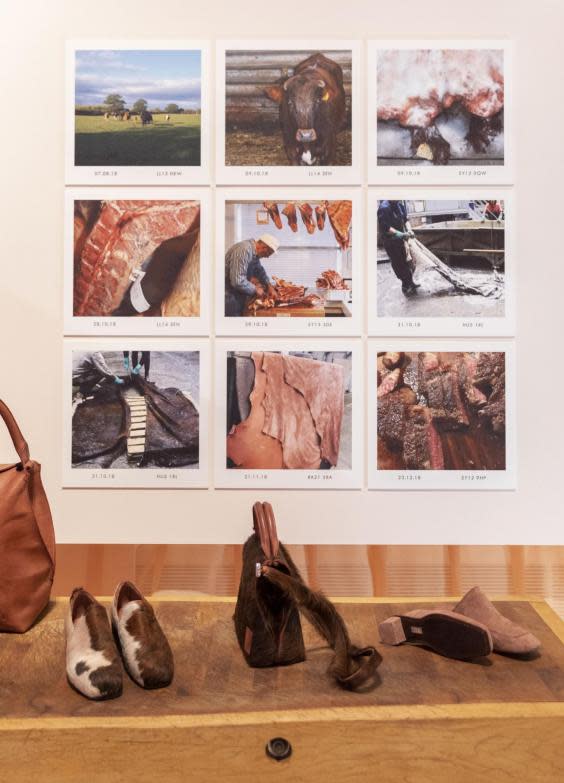Food: Bigger Than the Plate at the V&A Review – a curious delight, just don't go in hungry
I must confess that I left the Victoria and Albert Museum’s FOOD: Bigger Than the Plate exhibition feeling very hungry. Food, food, everywhere, but hardly a morsel to eat. Yes, I was able only to partially fulfil a long-standing ambition I never knew I had, by meeting - but not eating - the “sausage of the future”.
The sausage of the future really has been created by someone called Carolien Niebling (not pronounced “nibbling”). There’s more than one sausage of the future, in fact. There’s a neat liver sausage quartered with some quince jelly; a fruit sausage comprising figs, prunes and nits, made to look like black pudding; and more traditional salami with grubs in it. But, charming as Ms Niebling was, she could only show me images of mouth-watering products – no samples, sorry.
In fact, the only “taste experiences” allowed were some sips of Company Drinks’ admittedly excellent and wacky concoctions (eg Japanese Knotweed squash, Birch sap, Green Hop tonic), plus something from the LOCI Food Lab. This is “a traveling food stand for prototyping, serving and debating a range of bioregional food futures in different cities around the world”. You state, via tablet, naturally, your foodie priorities, and then science and the chefs do the rest.
For what I was expecting to be a snackette, I chose “Delicious”, Traditional and Zero Waste, and was served up a “cultivated crisp” (made from English cucumber, grown in Maidstone and dried in Kent), with “wild spread” (foraged English mushroom and wild herbs), plus some “revitalised relish” (out of tomatoes too ugly for local restaurants and supermarkets). Great, except the dainty dish is put together using tweezers, and the portion is the size of a fingernail. “Canapé” would be a gross exaggeration.
As for the almost extinct Veda loaf (confined now to Ulster for some reason), the Ooho! sustainable, edible water bottle and the tomatoes growing in a miniaturised sea container – I jsut had to imagine the taste. The oyster mushrooms growing out of coffee grounds were going to be harvested and tuned into delicious setbacks in the ace V&A café. A feast for the mind, then, but your tummy will have to wait. Christina Agapakis and Sissel Tolaas’ ‘Selfmade’ project, culturing cheese from human bacteria was also off limits.

Co-curator May Rosenthal Sloan is sympathetic to my hunger but explains that they’re hoping to get 200,000 visitors to FOOD, and that turning it into a catering event is probably unwise. I decide to push my luck still further and enquire where the KFC buckets are, or the Big Mac, that global symbol of cheap, industrialised food production. Maintaining her composure, as ever, Ms Rosenthal Sloan explains that her show – which has been some years in the making – is concerned with artists, social entrepreneurs and academics who want to “disrupt the system” and “re-imagine a better food future”, rather than “more of the same”. Or, as Tristram Hunt, Director of the V&A put it in his introductory remarks; offer those attending “seeds of thought”: Bit cheesy, but fair enough.

Some of the most delightful of the attractions in the exhibition are quite inedible anyway, and might just succeed on taking your mind off a cheeky Nandos. The ceramic containers glazed with urine, for example, are distracting, and the Merdacotta toilet pans manufactured out of clay and, er, cow pats were also quite effective appetite suppressants. A four-wheel drive quadribike – a ‘Bicitractor’ – was also distracting, though the thin tyres didn’t seem to me suitable for a muddy field – posing round Hoxton might be more like it. Michael Zee’s pretty images of the breakfasts he makes for himself and his partner Mark are featured here as well as on his hugely popular Instagram account @SymmetryBreakfast.
German artist Uli Westphal’s eye-catching, and also symmetrical, collages explore the way nature and agriculture are portrayed in bogus idyllic style in supermarket packaging – and labelling from Waitrose, Morrisons and Sainsbury’s make up the triptych of landscapes with unnaturally happy looking pigs, cattle and, oddly enough, eels.

My favourite items in the show were the tableware. Novelty plastic cutlery (by Jinyhun Jeon of Eindhoven and Seoul) are designed to “stimulate a deeper range of senses”, though, by the looks of them they’d be just at home in the bedside cabinet as the kitchen drawer.
Most delectable was the collection of traditionally-crafted “Brexitware”, adapted from the old “willow Tree” design, with some contemporary references. The Hard Brexit and Soft Brexit egg cups are the cutest bits of political memorabilia I’ve ever seen. Congratulations, then, to their creator, Harriet Coles, and the Edwards and Lockett company of Stoke-on-Trent for manufacturing them in such classy fashion. Ironically Stoke is the “Brexit capital” of Britain with its record-breaking (69.7 per cent) Leave vote in 2016. And to think Tristram Hunt himself was once the MP there. Small world.
Anyway, the Brexitware egg cups irresistible. I bought a pair, and I don’t even like eggs. Or Breggsit.
FOOD: Bigger than the Plate is on at the Victoria and Albert Museum from 18 May to 20 October 2019. Advance tickets are £17, concession from £13. FOOD is co-curated by Catherine Flood and May Rosenthal Sloan. It is sponsored by BaxterStorey.

